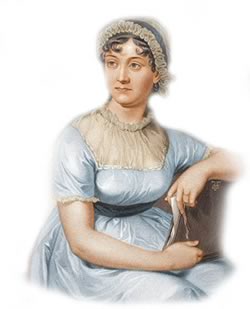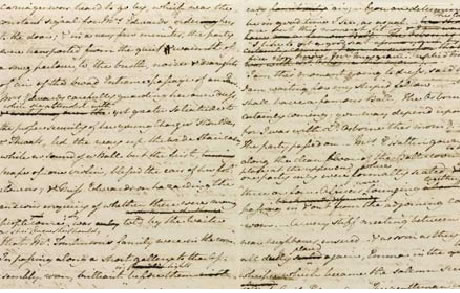
Famous Women

Jane Austen
Jane Austen sold her first manuscript Northanger Abbey to a publisher for £10 (£670 today) in 1803 aged 28. In 1815 she used the proceeds of Emma to buy back the still unpublished manuscript. It was published after her death when the popularity of her works had soared.
Jane Austen's first successful novel was Sense and Sensibility. In 1811, 750 copies of the book were printed and it sold out in just two years, making Austen a profit of £140 (£6,950). This was a considerable sum compared to other women writers of the time.
By comparison, Jane's contemporary Mary Shelley lived in poverty despite writing Frankenstein, one of the most popular novels of the 19th century.
Jane Austen became a minor celebrity in her time. Even the Prince Regent complimented her work . She famously said "a large income, is the best recipe for happiness I have ever heard of'. But sadly for Jane, she achieved only moderate financial success.
The £10,000 per annum income that the fictional Mr Darcy received was a pipedream to her. Despite her success, when Austen died in 1817, her total assets amounted to less than £800 (approx £41,800 today). Her will left most of this to her sister Cassandra who had nursed her through her illness.
Since her death, Jane Austen's works have become hugely popular and first editions of her novels are very valuable. In 2003, a first edition of 'Pride and Prejudice' sold for £40,000. Various adaptations of her works have been highly successful with the latest film of Pride and Prejudice making £63.2m worldwide.
A draft of Jane Austen's unpublished novel The Watsons, which was written in about 1804, sold at Sotheby's in 2011 for almost £1m! The heavily corrected manuscript from The Watsons, written in about 1804, was acquired by the Bodleian library at Oxford.

Famous Women who love the works of Jane Austen
Sandy Lerner made her money in Silicon valley, becoming an instant millionaire, when she sold her stake in Cisco systems. She is a dedicated fan of Austen and has read all six of the novels many times and her favourite, 'Persuasion', more than 70 times.
Lerner paid £1.25 million for the crumbling Chawton House in Hampshire, once owned by Jane Austen's brother and set in 275 acres. Austen lived at Chawton House for the last eight last years of her life and from where she published four novels.
Lerner has spent a further £10 million converting it into a library and study centre, equipped with all her beautiful, arcane books. It is now open to the public. This is a remarkable achievement by Lerner, as the house had fallen into terrible disrepair.
Thanks to the efforts and funding of Sandy Lerner, Chawton attracts an annual 50,000 visitors from 20 countries. She has built up the best private library of early English women's literature in the world.
The Janeites
In 1940 a small group of residents, distressed at the dilapidated condition of Jane’s last home, started the Jane Austen Society to try and help. They became known as the Janeites — a term first coined by Rudyard Kipling. Today there are 2,000 Janeites in the UK and flourishing sister societies were formed in America in 1979, Australia (1989) and Japan (2006).
Back in 1946, it was clear that, although membership had risen to 285, they simply did not have the funds to do much good. A letter was therefore sent to The Times that year seeking national support. A solicitor called Edward Carpenter saw it and bought the cottage in memory of his son, who had died in the war. It opened to the public in 1949.
Jane Austen's works where masterpieces of comedy and irony. The themes of health and wealth feature prominently in all of her novels. Her heroines all face a nineteenth century truth about money. They all knew that to be a woman and poor in that period was one of the worst fates that could befall them.
The subject of wealth was one which the heroines discussed frequently. They commonly believed that to stand a good chance in the marriage market you needed a sum of £10,000. £30,000, MADE you an heiress. The Interest to be calculated at a uniform rate, allowing a prospective husband to estimate the wealth that would become his after marriage.
A poor woman needed good manners and a pretty face, embodied in Elizabeth Bennett who despised the idea of a loveless marriage, in Pride and Prejudice. The health and wealth themes are both prominent focuses in Jane Austen's novels. If Jane Austen were alive today, she may well have been the creator of our wealth and wellbeing section!
Jane Austen found that having no real money of her own, was very limiting. However, she had many of the material trappings of wealth, like a servant. But for the majority of her life she had little money of her own. She was forced to rely on her family for much of what she desired.
She could not live where she pleased or travel as she pleased. We can also sense her frustration that her plans took second place to accommodate others. In real terms, Jane Austen enjoyed none of the financial independence that we can enjoy today.
From her unfinished novel The Watsons and Emma Watson, Jane Austen's frustration is clearly vocalised when Emma Watson tells Lord Osbourne, in response to his suggestion that women can always find the money to do what they want to do. "Female economy can do a great deal my Lord, but it cannot turn a small income into a large one". There has been speculation that this novel was never properly finished because the heroine mirrored too closely her own life.
Fortunately Jane Austen did find a way to make a little money through her writing. But,considering that these were some of the greatest books ever written, it was a paltry amount. The money was just enough to buy her some degree of the independence she sought. One of her joys was her ability to give gifts, on one occasion to her sister Cassandra. She said "Do not refuse me, for I am very rich".
Jane Austen understood the value of money and knew what it had to do with happiness. It was not the top priority for her personally, or of her heroines.
What can we learn from Jane Austen?
Because of the financial standing of women in Jane Austen's time, there is very little we can learn from a purely financial point of view. However, we may reflect how much better our position is today, compared with that of the women of the 19th century.
There are some women today whose situation has not improved greatly since those times. Thankfully, our status has improved drastically in the last 150 years for the vast majority of us. Perhaps we should pose a question on behalf of Jane Austen and the19th century women portrayed in her novels and indeed the women whose fortunes in some countries of the world have changed little.
What are we doing with our ability to self determine and the opportunity to amass wealth in our own right?
From Jane Austen, we can learn to take advantage of the opportunities we have before us. Women in most of the world are not only able to control their wealth and wellbeing, but also affect change for others. Many women in the 19th century would have longed for the opportunities we have today.
Pink Investments provides the tools to optimise the financial opportunities that women have today. As women grow in financial strength, so grows society and with it further opportunities will arise. The women of Pink Investments today are working to create a stronger financial future for the children of tomorrow.
Disclaimer: All the information above is provided as a service for individuals and institutions. It should in no way be construed as a recommendation as an investment. Investment decisions should be based on the risk tolerance and planning horizon of the investor. Market participants must understand that past performance is also not a guarantee or predictor of future results.
 Youtube
Youtube Facebook
Facebook
 Twitter
Twitter LinkedIn
LinkedIn
 Subscribe
Subscribe
